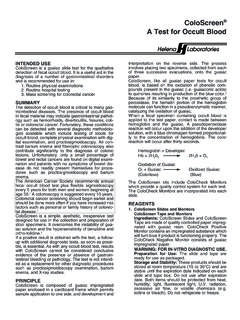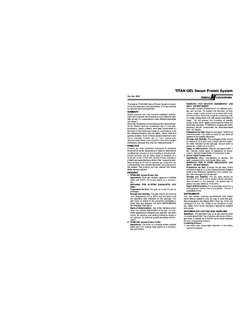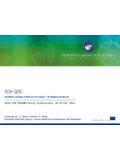Transcription of PLATELETWORKS ADP and Collagen - Helena Laboratories
1 INTENDED USE PLATELETWORKS is an in vitro diagnostic screening assay for the determination of % platelet aggregation or % platelet inhibition in fresh whole blood . The samples may be taken during cardiac interventional procedures or other surgical or treatment settings facing similar risks from thrombosis. PLATELETWORKS may also be used when there are general concerns about the effects of drug therapies on platelet function. The change in platelet count due to activation and aggregation of functional platelets is measured using an electronic impedance-based cell anucleate, multifunctional platelet circulates as a cellular component of the blood and provides the first line of defense against bleeding. Subsequent to vasculature injury, platelets adhere to Collagen that becomes exposed as a result of endothelial disruption. They then undergo a radical shape change and release adenosine diphosphate (ADP), a physiological agonist which activates additional platelets.
2 Ultimately, a primary hemostatic plug is formed due to the cyclic and self-perpetual stimulation of platelets as they aggregate, release other agonists, and interact with the proteins of the coagulation cascade to form a fibrin determine the functionality of primary hemostasis in a given patient, platelets must be assessed in two ways: 1) by measuring the platelet count, and 2) by testing platelet function. If the platelet count is low (generally < 50,000/ L), the ability of the platelets to aggregate properly may be compromised. However, even with a normal platelet count, the platelets may be dysfunctional due to congenital or acquired conditions. If platelets are not aggregating normally, the outcome may be either hemorrhage or unwanted clotting. More specifically, inadequate platelet aggregation may lead to bleeding complications, and platelets that are excessively activated can potentially initiate a thrombotic event such as myocardial infarction, ischemia, stroke, reocclusion following coronary angioplasty, and a result, it may be desirable to assess platelet count and platelet aggregation or platelet inhibition in certain patient populations.
3 In particular, these include patients undergoing cardiopulmonary bypass, coronary angioplasty, and individuals receiving drug therapies known to affect platelet aggregation. Test results obtained may be useful for pre-and post-surgical determinations for more definitive therapy. Further, platelet aggregation studies performed using multiple agonists may also be helpful in this platelet aggregometry, the reference method and gold standard for testing platelet function, is based on the addition of platelet agonists such as Collagen , ADP and others to a blood sample (usually platelet rich plasma). Platelet aggregation may be assessed using these agonists, individually and/or as a panel, as part of the diagnostic intervention into various conditions of congenital and acquired platelet dysfunction. The chart below represents what the different agonist results suggest at It may be beneficial for any abnormal baseline results to be further investigated using additional platelet testing methodologies such as platelet count, bleeding time, assessment of platelet morphology by electron microscopy, measurement of platelet-specific proteins indicative of platelet activation, and others.
4 Such follow-up testing should be conducted in light of patient history, the clinical presentation, and physician Collagen ADPA fibrinogenemia N DBernard Soulier Syndrome N NGlanzman s Thrombasthenia D DAspirin Ingestion D Dvon Willebrand s Syndrome N NUremia D DStorage Pool Disease D DN = Normal, D = DecreasedThese agonists serve to stimulate the platelet, and the pattern of aggregation is recorded on a strip chart. The curve is then interpreted by the operator. Unfortunately, the reproducibility of results is dependent on many factors, and the test is highly labor intensive and expensive. For EnglishPLATELETWORKS ADP and Collagenthese reasons, platelet aggregometry is not routinely performed in most Laboratories . As a result, platelet aggregation testing capabilities have been largely unavailable despite the strong clinical need for this PLATELETWORKS methodology is an adaptation of platelet aggregometry that is extremely simple, inexpensive, and quick to perform (results are available in about five minutes).
5 This two-step method involves using a cell counter to measure total platelet count in a whole blood sample and then to redetermine the platelet count on a second sample that has been exposed to a known platelet agonist. The agonist will stimulate those platelets which are functional to aggregate into clumps, and they will not be counted as platelets in the second sample. The difference in the platelet count between samples one and two provides a direct measurement of platelet aggregation and is reported as percent aggregation as per the following equation:Baseline Platelet Count Agonist Platelet Count X 100 = % AggregationBaseline Platelet CountPlatelets rendered inactive or non-functional by pharmaceutical intervention are considered inhibited. The PLATELETWORKS results may be expressed as percent inhibition instead of percent Platelet Count X 100 = % Inhibition Baseline Platelet CountUsers may refer to the % Aggregation/Inhibition Chart in each box of PLATELETWORKS In Vitro Diagnostic UseEach PLATELETWORKS kit contains 25 baseline tubes and 25 agonist tubes.
6 The tube contents are as follows: EDTA (baseline) tube - mL of K3 EDTA solution ( mg) ADP tube (gray top) - Upon reconstitution with mL fresh whole blood , it contains approximately 20 M ADP (bacterial) lyophilized in the presence of sodium citrate and buffer salts. Collagen tube (white top) - approximately 10 g liquid Collagen (equine tendon) in sodium citrate for use with mL fresh whole : All reagents are of non-human origin. Each PLATELETWORKS tube requires a cc fresh, human blood and StabilityAll PLATELETWORKS tubes should be stored at 2-8 C prior to use. When stored at 2-8 C, the tubes are stable until the marked expiration date. When stored at room temperature (20-24 C), ADP tubes are stable for one month. However, it is not recommended that Collagen tubes be stored at room temperature for longer than one PLATELETWORKS tubes can be run on any hematology analyzer utilizing impedance methodology for determining platelet counts from whole blood .
7 For detailed instructions, refer to the appropriate Operator s COLLECTION AND PREPARATIONB lood samples should be collected via routine method ( , indwelling catheter line, venipuncture, etc.). No anticoagulation of the blood is required. Samples should be drawn in a manner to prevent contamination with tissue thromboplastin, indwelling IV solutions, and other interfering substances. blood collection guidelines are described in the CLSI document H3-A6, Vol. 27, No. 26, Oct., 2007: Procedure for the Collection of Diagnostic blood Specimens by Venipuncture .VenipunctureWhen using a venipuncture technique, needles of 19 to 22 gauge should be used to reduce the potential for platelet activation during specimen collection. For pediatric patients, a 21 to 23 gauge needle may be used. Withdraw cc of blood and discard it. Then collect a cc sample of fresh whole blood for testing ( cc for baseline tube and cc for agonist tube).
8 Extracorporeal LineUsing a two-syringe technique, flush the extracorporeal blood access line by withdrawing cc of blood into a syringe and discarding it. Then use a second syringe to obtain a cc sample of fresh whole blood for testing ( cc for baseline tube and cc for agonist tube).Indwelling Catheter LineDiscontinue fluids drip, if necessary, and flush the line with 5 mL saline. Using a two-syringe technique, withdraw cc of blood into a syringe and discard it. Then use a second syringe to obtain a cc sample of fresh whole blood for testing ( cc for baseline tube and cc for agonist tube).NOTE: The appropriate amount of blood from the hypodermic needle/syringe must be added to the EDTA and agonist tubes within one minute after completion of the Cat. No. 5860, 5862, 5850, 5852, 5854 PROCEDUREM aterials ProvidedThe PLATELETWORKS Kits include agonist tubes, baseline tubes and a % Aggregation/Inhibition chart.
9 A PLATELETWORKS Aggregation/Inhibition Calculation Wheel (584) is also available upon Cat. Collagen Kit 5862 25 Collagen tubes 25 Baseline (EDTA) tubesPlateletworks ADP Kit 5860 25 ADP tubes 25 Baseline (EDTA) tubes PLATELETWORKS Combo-15 Kit 5850 15 Collagen Tubes 15 ADP Tubes 15 Baseline (EDTA) TubesPlateletworks Combo-25 Kit 5852 25 Collagen Tubes 25 ADP TubesPlateletworks Combo-10 Kit 5854 10 Collagen Tubes 10 ADP Tubes 10 Arachidonic Acid Tubes 10 Baseline (EDTA) TubesMaterials Required but Not Provided Impedance cell counterBlood collection materials (syringes, blood collection set, etc.)Step-by-Step MethodNote: If kept refrigerated at 2-8 C, allow PLATELETWORKS tubes to equilibrate to room temperature (20-24 C) before adding Obtain the desired fresh whole blood sample. A cc whole blood sample is required for each agonist tube and each baseline Immediately dispense cc of blood into each of the baseline tube and the agonist Mix each tube (baseline and agonist) vigorously 15 to 20 times to ensure adequate The baseline tube is then run on an appropriate cell counter, recording the platelet Mix the ADP tube an additional 3 to 5 times and run on the cell counter.
10 Record the platelet The Collagen tube is mixed 4-5 times each minute for 4 The Collagen tube is then run on a cell counter, recording the platelet The percent platelet aggregation is then calculated a) from the % Aggregation/Inhibition Chart supplied in the package of tubes. b) using the PLATELETWORKS Calculation Wheel. c) calculated by the appropriate Control Quality control testing of the cell counter used to perform the PLATELETWORKS assay should be completed during each shift the system is used. These results will ensure that the instrument is functioning properly. It is suggested that each laboratory establish its own normal range. No commercial controls for platelet aggregation testing are available. blood drawn from healthy adults may be used as normal controls for the PLATELETWORKS assay. These individuals must be free from any medication known to affect platelet function for a minimum of 5 days and should have prior platelet aggregation tests that fall within the normal range established by the laboratory.














